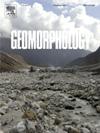Bedload response to dam removal: Results from a 6-year particle tracking survey in the Leitzaran River (Basque Country)
IF 3.1
2区 地球科学
Q2 GEOGRAPHY, PHYSICAL
引用次数: 0
Abstract
Dams, weirs and transverse barriers to rivers interrupt sediment continuity and reduce sediment supply downstream. In this regard, dam removal is an increasingly used river restoration measure to recover longitudinal connectivity of sediment, among many other river processes. In this work we present a 6-year (from 2016 to 2022) monitoring of bedload transport before, during and after the removal of the 7-meters high Olloki dam in the Leitzaran River (Basque Country). The removal process started in 2018 with the upper 3 m and was completed in 2019 with the remaining 4 m of the dam. To monitor bedload transport, we seeded RFID-tagged stones in three reaches: a control reach unaffected by the dam, a reach immediately upstream of the dam, and a reach downstream of the dam. We deployed 300 tagged stones each year (100 by reach), i.e., 1800 in total. We measured important mobilization and displacement of tracer stones (with maximum travel distances of ∼8.8 km of tracers seeded upstream the Olloki dam) during an active hydrological year following the complete removal of the dam, with some tagged particles even travelling across a downstream weir. We also reported changes in the progression of tagged stones in the dam-affected reaches (upstream and downstream) with the removal, with further and faster dispersal of sediments once the dam was removed. In addition, in these reaches we estimated larger volumes of mobilized bedload in the three years following removal than in the previous years, especially in the upstream reach. In this regard, the relationship between bedload and cumulated energy suggests that less energy was expended in the upstream reach for mobilizing bedload once the removal of the dam was completed. Conversely, in the control reach no major changes were observed before and after the removal of the dam; this reach showed only an increase in sediment mobilization during the last hydrological year, which was the most hydrologically active of the whole monitoring period. In summary, our tracer observations document that travel distances and mobilization volumes are considerably increased with dam removal, especially once the dam was completely removed.
求助全文
约1分钟内获得全文
求助全文
来源期刊

Geomorphology
地学-地球科学综合
CiteScore
8.00
自引率
10.30%
发文量
309
审稿时长
3.4 months
期刊介绍:
Our journal''s scope includes geomorphic themes of: tectonics and regional structure; glacial processes and landforms; fluvial sequences, Quaternary environmental change and dating; fluvial processes and landforms; mass movement, slopes and periglacial processes; hillslopes and soil erosion; weathering, karst and soils; aeolian processes and landforms, coastal dunes and arid environments; coastal and marine processes, estuaries and lakes; modelling, theoretical and quantitative geomorphology; DEM, GIS and remote sensing methods and applications; hazards, applied and planetary geomorphology; and volcanics.
 求助内容:
求助内容: 应助结果提醒方式:
应助结果提醒方式:


